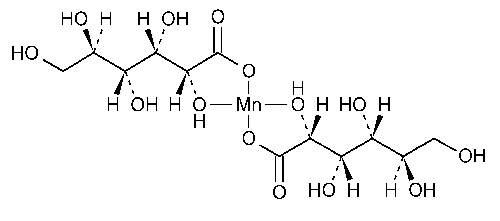Manganese Gluconate
Bis(D-gluconato-O1,O2)manganese.
Manganese D-gluconate (1:2).
Dihydrate 481.27
»Manganese Gluconate is dried or contains two molecules of water of hydration.It contains not less than 98.0percent and not more than 102.0percent of C12H22MnO14,calculated on the anhydrous basis.
Packaging and storage—
Preserve in well-closed containers.
Labeling—
The label indicates whether it is the dried or the dihydrate form.
Identification—
A:
Asolution (1in 20)responds to the tests for Manganese á191ñ.
Water,Method Iá921ñ(where labeled as the dried form):
between 3.0%and 9.0%,the determination being performed by stirring the mixture containing the Test preparation,maintained at a temperature of 50 ,for 30minutes before titrating with the Reagent:where labeled as the dihydrate it is between 6.0%and 9.0%.
,for 30minutes before titrating with the Reagent:where labeled as the dihydrate it is between 6.0%and 9.0%.
Chloride á221ñ—
A1.0-g portion shows no more chloride than corresponds to 0.70mLof 0.020Nhydrochloric acid (0.05%).
Sulfate á221ñ—
A2.0-g portion shows no more sulfate than corresponds to 4.0mLof 0.020Nsulfuric acid (0.2%).
Limit of lead—
[NOTE—For the preparation of all aqueous solutions and for the rinsing of glassware before use,employ water that has been passed through a strong-acid,strong-base,mixed-bed ion-exchange resin before use.Select all reagents to have as low a content of lead as practicable,and store all reagent solutions in containers of borosilicate glass.Cleanse glassware before use by soaking in warm 8Nnitric acid for 30minutes and by rinsing with deionized water.]
Ascorbic acid–sodium iodide solution—
Dissolve 20g of ascorbic acid and 38.5g of sodium iodide in water in a 200-mLvolumetric flask,dilute with water to volume,and mix.
Trioctylphosphine oxide solution—
[Caution—This solution causes irritation.Avoid contact with eyes,skin,and clothing.Take special precautions in disposing of unused portions of solutions to which this reagent is added.
]Dissolve 5.0g of trioctylphosphine oxide in 4-methyl-2-pentanone in a 100-mLvolumetric flask,dilute with the same solvent to volume,and mix.
Standard solution andBlank—
Transfer 5.0mLof Lead Nitrate Stock Solution,prepared as directed in the test for Heavy Metals á231ñ,to a 100-mLvolumetric flask,dilute with water to volume,and mix.Transfer 2.0mLof the resulting solution to a 50-mLvolumetric flask.To this volumetric flask and to a second,empty 50-mLvolumetric flask(Blank)add 10mLof 9Nhydrochloric acid and about 10mLof water.To each flask add 20mLof Ascorbic acid–sodium iodide solution and 5.0mLof Trioctylphosphine oxide solution,shake for 30seconds,and allow to separate.Add water to bring the organic solvent layer into the neck of each flask,shake again,and allow to separate.The organic solvent layers are the Blankand the Standard solution,and they contain 0.0µg and 2.0µg of lead per mL,respectively.
Test solution—
Add 1.0g of Manganese Gluconate,10mLof 9Nhydrochloric acid,about 10mLof water,20mLof Ascorbic acid–sodium iodide solution,and 5.0mLof Trioctylphosphine oxide solutionto a 50-mLvolumetric flask,shake for 30seconds,and allow to separate.Add water to bring the organic solvent layer into the neck of the flask,shake again,and allow to separate.The organic solvent layer is the Test solution.
Procedure—
Concomitantly determine the absorbances of the Blank,Standard solution,and Test solutionat the lead emission line at 283.3nm,with a suitable atomic absorption spectrophotometer (see Spectrophotometry and Light-Scattering á851ñ)equipped with a lead hollow-cathode lamp and an air–acetylene flame,using the Blankto set the instrument to zero.In a suitable analysis,the absorbance of the Standard solutionand the absorbance of the Blank are significantly different:the absorbance of the Test solutiondoes not exceed that of the Standard solution(0.001%).
Heavy metals á231ñ—
Dissolve 1g in 10mLof water,add 6mLof 3Nhydrochloric acid,and dilute with water to 25mL:the limit is 20µg per g.
Reducing substances—
Transfer 1.0g to a 250-mLconical flask,dissolve in 10mLof water,and add 25mLof alkaline cupric citrate TS.Cover the flask,boil gently for 5minutes,accurately timed,and cool rapidly to room temperature.Add 25mLof 0.6Nacetic acid,10.0mLof 0.1Niodine VS,and 10mLof 3Nhydrochloric acid,and titrate with 0.1Nsodium thiosulfate VS,adding 3mLof starch TSas the endpoint is approached.Perform a blank determination,omitting the specimen,and note the difference in volumes required.Each mLof the difference in volume of 0.1Nsodium thiosulfate consumed is equivalent to 2.7mg of reducing substances (as dextrose):the limit is 1.0%.
Organic volatile impurities,Method Iá467ñ:
meets the requirements.
Assay—
Dissolve about 700mg of Manganese Gluconate,accurately weighed,in 50mLof water.Add 1g of ascorbic acid,10mLof ammonia-ammonium chloride buffer TS,and 0.1mLof eriochrome black TS,and titrate with 0.05Medetate disodium VSuntil the solution is deep blue in color.Each mLof 0.05Medetate disodium is equivalent to 22.26mg of C12H22MnO14.
Auxiliary Information—
Staff Liaison:Lawrence Evans,III,Ph.D.,Scientist
Expert Committee:(DSN)Dietary Supplements:Non-Botanicals
USP28–NF23Page 1182
Pharmacopeial Forum:Volume No.29(3)Page 636
Phone Number:1-301-816-8389
